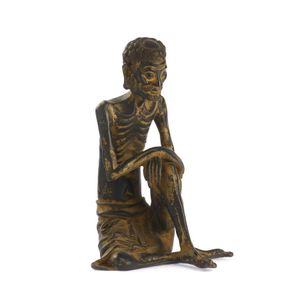Bruno Zach's "Spanish Shawl" Bronze Dancer
You must be a subscriber, and be logged in to view price and dealer details.
Subscribe Now to view actual auction price for this item
When you subscribe, you have the option of setting the currency in which to display prices to $Au, $US, $NZ or Stg.
- Bronze - An alloy of copper and tin, traditionally in the proportions of about 9 parts of copper to 1 part of tin.
The discovery of bronze in Western Asia in the 4th century enabled people to create metal objects which were superior to those previoulsy possible because of its strength and hardness, and it has been used throughout the world for weapons, coins, tools, statuary and other decorative items.
It is very fluid in a molten state, and its hardness, strength when set, and non-corrosive properties makes it most suitable for casting sculpture. - Cold Painted - This is term applied to so-called "Vienna bronzes" manufactured in that city starting in late part of the 19th century, and it continued in the early 20th century, but was also used by sculptors working in other areas of Europe at the time..
Traditionally bronzes are finished by treating them with various acids and chemicals and heats, and the patina is incorporated into the surface of the piece.
A cold-painted bronze is decorated with oil paints. The color was not fired, hence the term "cold painted". Reputedly the painting was carried out mainly by women working at home, a typical cottage industry. - Circa - A Latin term meaning 'about', often used in the antique trade to give an approximate date for the piece, usually considered to be five years on either side of the circa year. Thus, circa 1900 means the piece was made about 1900, probably between 1895 and 1905. The expression is sometimes abbreviated to c.1900.
This item has been included into following indexes:
Visually similar items

South East Asian cast bronze figure of D?pankara Buddha, probably 16th century, in the Ayudhya style, standing up with his right hand in gesture of protection, on wooden base (A/F). Height 48.5 cm

Bronze on marble of a nude man of a young nude man sitting over a plinth or column and looking down toward the ground, standing on an oval marble base., height 39 cm

A Chinese bronze arhat, the slender arhat seated with his eyes closed as if meditating in half-leg position, his robe flowing from his waist down to reveal a torso with visible ribs, two hands resting on the left knee, 8 cm high

A 19th century bronze censer on caryatid feet, the cover with a cupid
